�
Table of Contents (summary)
Breaking the Surface: a quick dip
A Trip to Objectville: yes, there will be objects
Know Your Variables: primitives and references
Extra-Strength Methods: flow control, operations, and more
Using the Java Library: so you don’t have to write it all yourself
Better Living in Objectville: planning for the future
Serious Polymorphism: exploiting abstract classes and interfaces
Life and Death of an Object: constructors and memory management
Intro
1
2
3
4 How Objects Behave: object state affects method behavior
5
6
7
8
9
10 Numbers Matter: math, formatting, wrappers, and statics
11 Risky Behavior: exception handling
12 A Very Graphic Story: intro to GUI, event handling, and inner classes
13 Work on Your Swing: layout managers and components
14
15 Make a Connection: networking sockets and multithreading
16 Data Structures: collections and generics
17 Release Your Code: packaging and deployment
18 Distributed Computing: RMI with a dash of servlets, EJB, and Jini
A
B
Saving Objects: serialization and I/O
xxi
1
27
49
71
95
125
165
197
235
273
315
353
399
429
471
529
581
607
649
659
677
Appendix A: Final code kitchen
Appendix B: Top Ten Things that didn’t make it into the rest of the book
Index
Table of Contents (the full version)
i Intro
Your brain on Java.
Who is this book for?
What your brain is thinking
Metacognition
Bend your brain into submission
What you need for this book
Technical editors
Acknowledgements
xxii
xxiii
xxv
xxvii
xxviii
xxx
xxxi
ix
�
1 Breaking the Surface
Java takes you to new places.
Virtual
Machines
Method Party()
0 aload_0
1 invokespe-
cial #1
4 return
Compiled
bytecode
Yo u B e t
S h o o t M e
The way Java works
Code structure in Java
Anatomy of a class
The main() method
Looping
Conditional branching (if tests)
Coding the “99 bottles of beer” app
Phrase-o-matic
Fireside chat: compiler vs. JVM
Exercises and puzzles
2
7
8
9
11
13
14
16
18
20
2 A Trip to Objectville
I was told there would be objects.
Chair Wars (Brad the OO guy vs. Larry the procedural guy)
Inheritance (an introduction)
Overriding methods (an introduction)
What’s in a class? (methods, instance variables)
Making your fi rst object
Using main()
Guessing Game code
Exercises and puzzles
28
31
32
34
36
38
39
42
x
�
3 Know Your Variables
Variables come in two flavors: primitive and reference.
24
size
int
Dog o bject
fido
Dog reference
Declaring a variable (Java cares about type)
Primitive types (“I’d like a double with extra foam, please”)
Java keywords
Reference variables (remote control to an object)
Object declaration and assignment
Objects on the garbage-collectible heap
Arrays (a fi rst look)
Exercises and puzzles
50
51
53
54
55
57
59
63
4 How Objects Behave
State affects behavior, behavior affects state.
pass-by-value means
pass-by-copy
copy of x
0 111
0
0
0
0
0 0 0 0 0111
X
int
Z
int
void go(int z){ }
foo.go(x);
Methods use object state (bark different)
Method arguments and return types
Pass-by-value (the variable is always copied)
Getters and Setters
Encapsulation (do it or risk humiliation)
Using references in an array
Exercises and puzzles
73
74
77
79
80
83
88
xi
�
5 Extra-Strength Methods
Let’s put some muscle in our methods.
Building the Sink a Dot Com game
Starting with the Simple Dot Com game (a simpler version)
Writing prepcode (pseudocode for the game)
Test code for Simple Dot Com
Coding the Simple Dot Com game
Final code for Simple Dot Com
Generating random numbers with Math.random()
Ready-bake code for getting user input from the command-line
Looping with for loops
Casting primitives from a large size to a smaller size
Converting a String to an int with Integer.parseInt()
Exercises and puzzles
96
98
100
102
103
106
111
112
114
117
117
118
il d
u
b
C o m
g
t
e
h
a m e
W e ’ r
k
n
S i
e
a
n
n
o
g
D o
a
t
6 Using the Java Library
Java ships with hundreds of pre-built classes.
- Julia, 31, hand model
Analying the bug in the Simple Dot Com Game
ArrayList (taking advantage of the Java API)
Fixing the DotCom class code
Building the real game (Sink a Dot Com)
Prepcode for the real game
Code for the real game
boolean expressions
Using the library (Java API)
Using packages (import statements, fully-qualifi ed names)
Using the HTML API docs and reference books
Exercises and puzzles
126
132
138
140
144
146
151
154
155
158
161
xii
�
7 Better Living in Objectville
Plan your programs with the future in mind.
Make it Stick
Understanding inheritance (superclass and subclass relationships)
Designing an inheritance tree (the Animal simulation)
Avoiding duplicate code (using inheritance)
Overriding methods
IS-A and HAS-A (bathtub girl)
What do you inherit from your superclass?
What does inheritance really buy you?
Polymorphism (using a supertype reference to a subclass object)
Rules for overriding (don’t touch those arguments and return types!)
Method overloading (nothing more than method name re-use)
Exercises and puzzles
168
170
171
172
177
180
182
183
190
191
192
8 Serious Polymorphism
Inheritance is just the beginning.
Object o = al.get(id);
Dog d = (Dog) o;
d.bark();
Object
e c t
Dog ob j
cast the Object
back to a Dog we
know is there.
o
Object
d
Dog
Some classes just should not be instantiated
Abstract classes (can’t be instantiated)
Abstract methods (must be implemented)
Polymorphism in action
Class Object (the ultimate superclass of everything)
Taking objects out of an ArrayList (they come out as type Object)
Compiler checks the reference type (before letting you call a method)
Get in touch with your inner object
Polymorphic references
Casting an object reference (moving lower on the inheritance tree)
Deadly Diamond of Death (multiple inheritance problem)
Using interfaces (the best solution!)
Exercises and puzzles
200
201
203
206
208
211
213
214
215
216
223
224
230
xiii
�
9 Life and Death of an Object
Objects are born and objects die.
l s
W h e n s o m e o n e c a l
t h e g o ( ) m e t h o d , t h i s
D u c k i s a b a n d o n e d . H i s
o n l y r e f e r e n c e h a s b e e n
r e p r o g r a m m e d f o r a
d i f f e r e n t D u c k .
Duck o b j e ct
d
Duck o b j e ct
p
a
e
H
‘d’ is assigned a new Duck object, leaving the
original (first) Duck object abandoned. That
first Duck is toast..
The stack and the heap, where objects and variables live
Methods on the stack
Where local variables live
Where instance variables live
The miracle of object creation
Constructors (the code that runs when you say new)
Initializing the state of a new Duck
Overloaded constructors
Superclass constructors (constructor chaining)
Invoking overloaded constructors using this()
Life of an object
Garbage Collection (and making objects eligible)
Exercises and puzzles
236
237
238
239
240
241
243
247
250
256
258
260
266
10 Numbers Matter
Do the Math.
Static variables
are shared by
all instances of
a class.
static variable:
iceCream
kid instance two
kid instance one
instance variables:
one per instance
static variables:
one per class
xiv
Math class (do you really need an instance of it?)
static methods
static variables
Constants (static fi nal variables)
Math methods (random(), round(), abs(), etc.)
Wrapper classes (Integer, Boolean, Character, etc.)
Autoboxing
Number formatting
Date formatting and manipulation
Static imports
Exercises and puzzles
274
275
277
282
286
287
289
294
301
307
310
�
11 Risky Behavior
Stuff happens.
thr o
w s an exception back
2
class Bar {
void go() {
moo();
}
int stuff() {
x.beep();
}
}
your code
1
calls risky method
class Cow {
void moo() {
if (serverDown){
explode();
}
}
}
class with a
risky method
Making a music machine (the BeatBox)
What if you need to call risky code?
Exceptions say “something bad may have happened...”
The compiler guarantees (it checks) that you’re aware of the risks
Catching exceptions using a try/catch (skateboarder)
Flow control in try/catch blocks
The fi nally block (no matter what happens, turn off the oven!)
Catching multiple exceptions (the order matters)
Declaring an exception (just duck it)
Handle or declare law
Code Kitchen (making sounds)
Exercises and puzzles
316
319
320
321
322
326
327
329
335
337
339
348
12 A Very Graphic Story
Face it, you need to make GUIs.
class MyOuter {
class MyInner {
void go() {
}
}
}
The outer and inner objects
are now intimately linked.
T h e s e t w o o b j e c t s o n t h e
h e a p h a v e a s p e c i a l b o n d . T h e
i n n e r c a n u s e t h e o u t e r ’ s
v a r i a b l e s ( a n d v i c e - v e r s a ) .
inn e
r
o u ter
Your fi rst GUI
Getting a user event
Implement a listener interface
Getting a button’s ActionEvent
Putting graphics on a GUI
Fun with paintComponent()
The Graphics2D object
Putting more than one button on a screen
Inner classes to the rescue (make your listener an inner class)
Animation (move it, paint it, move it, paint it, move it, paint it...)
Code Kitchen (painting graphics with the beat of the music)
Exercises and puzzles
355
357
358
360
363
365
366
370
376
382
386
394
xv
�
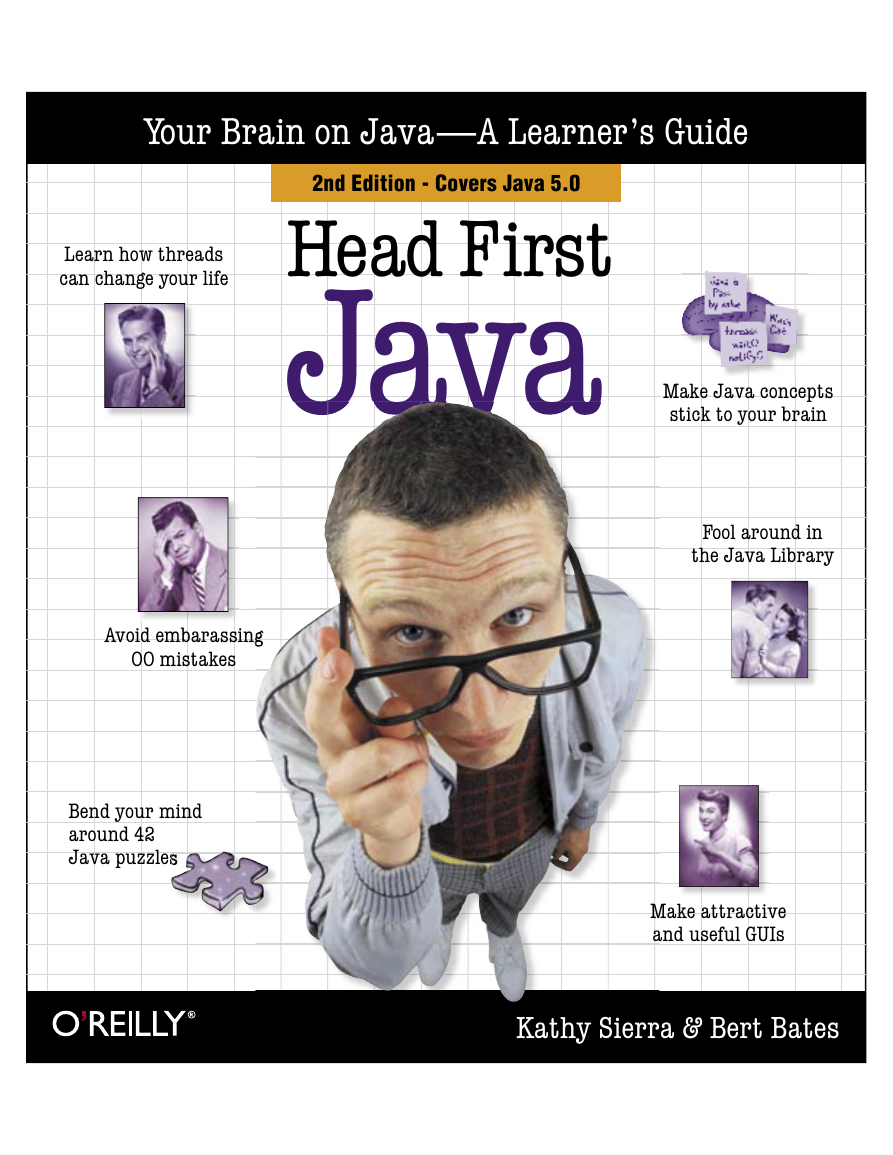
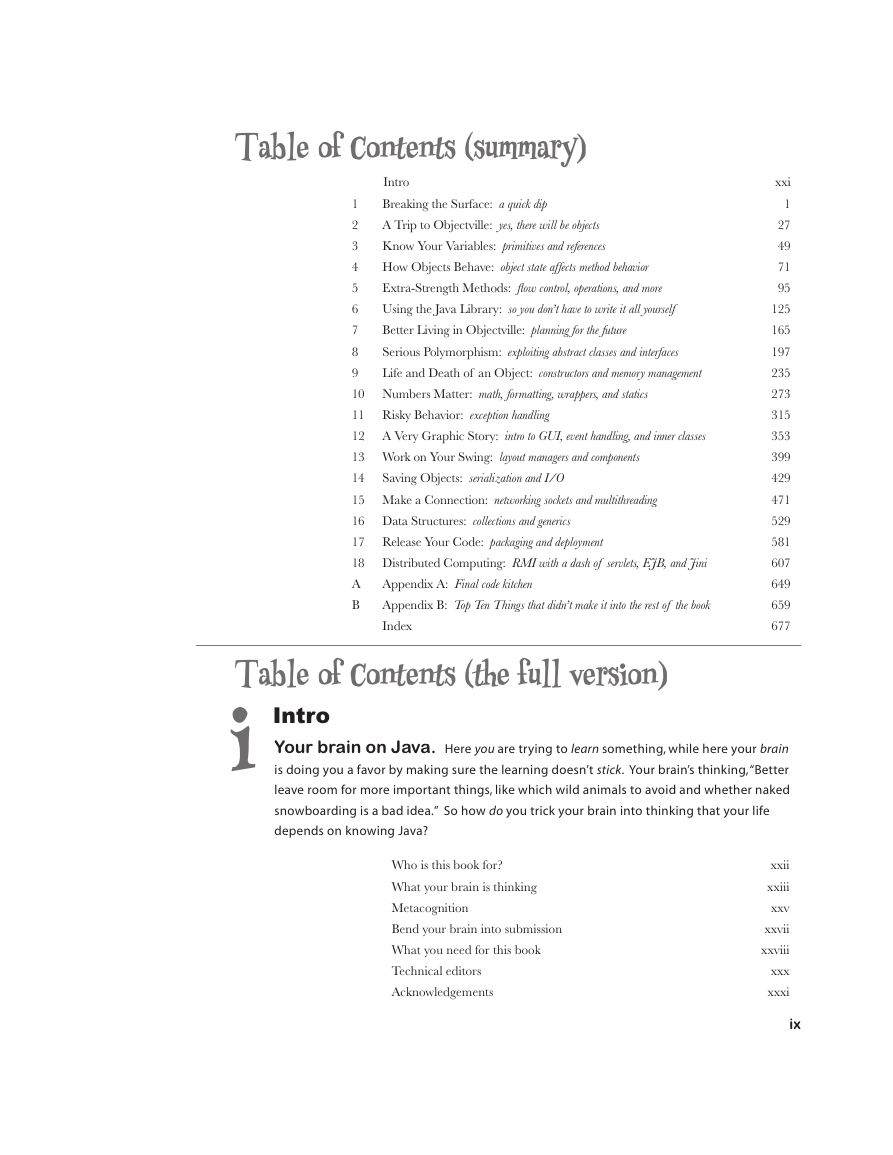
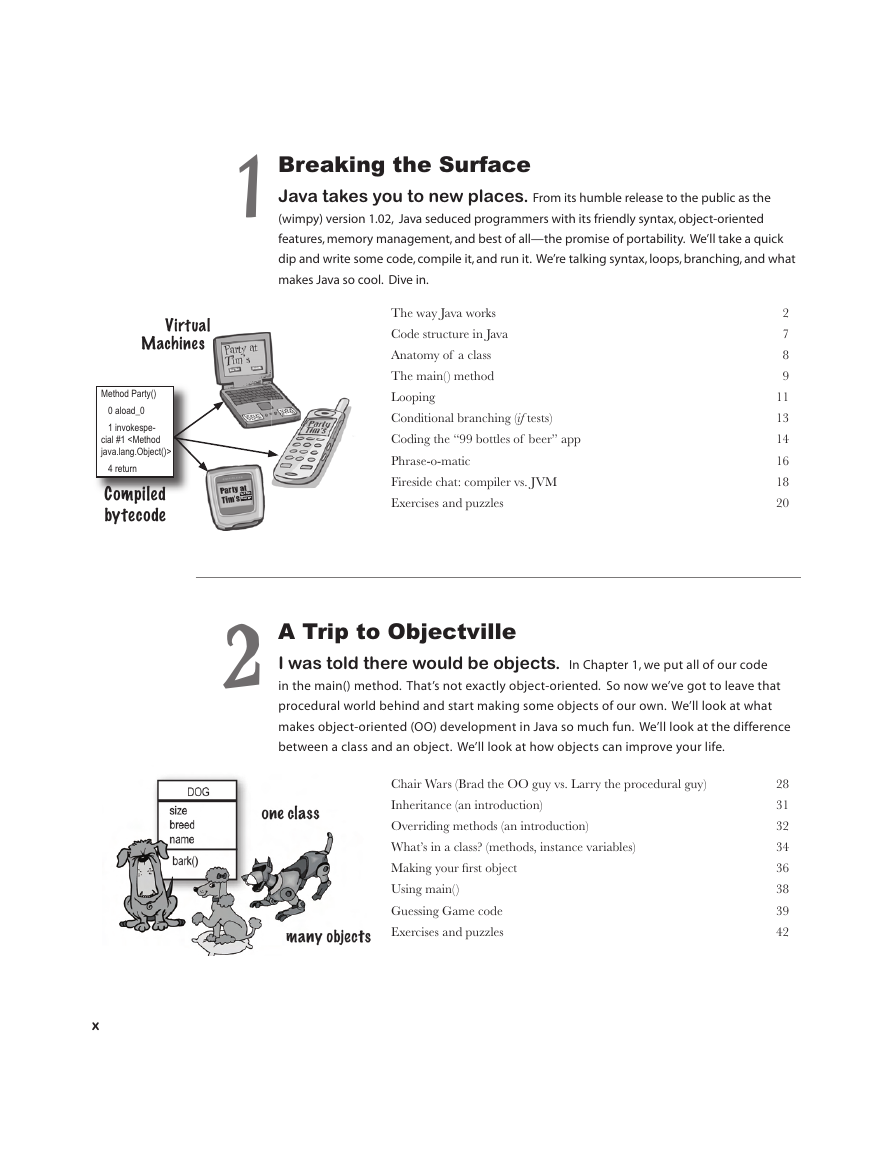
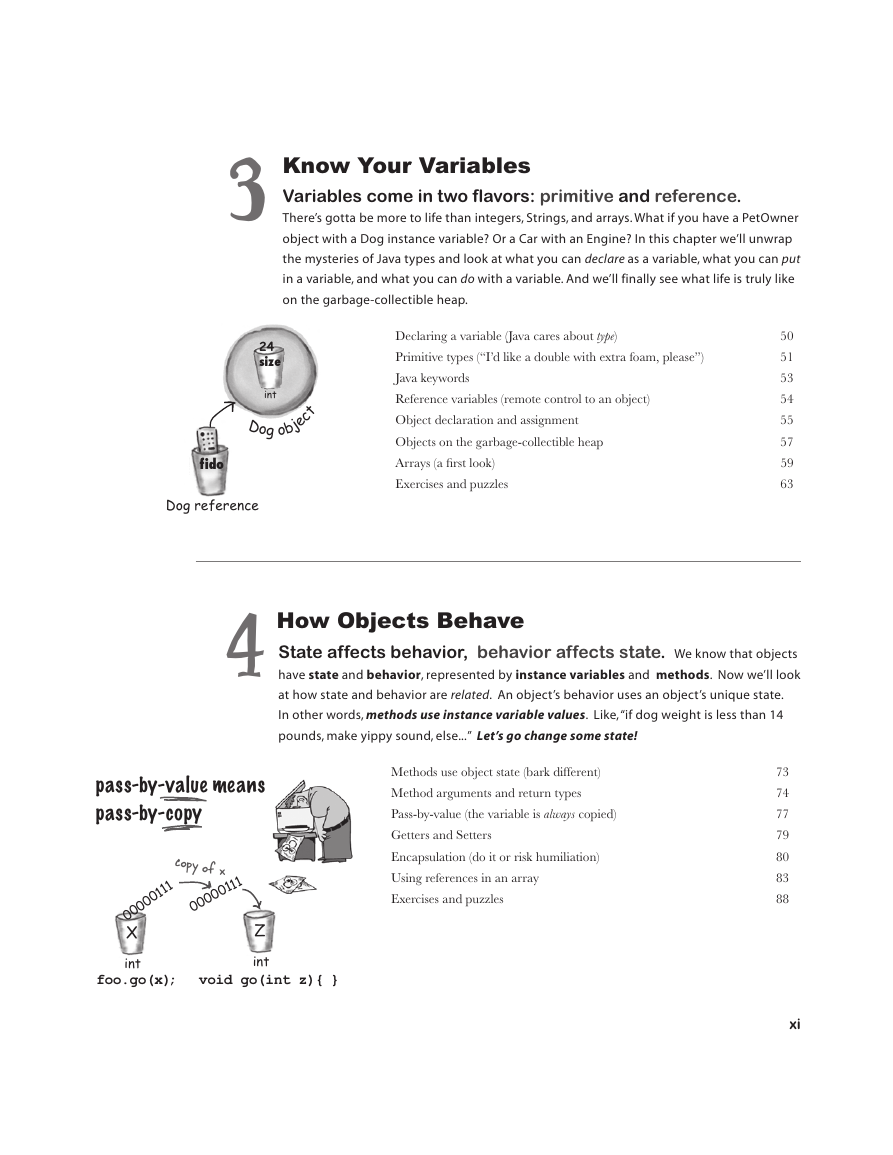
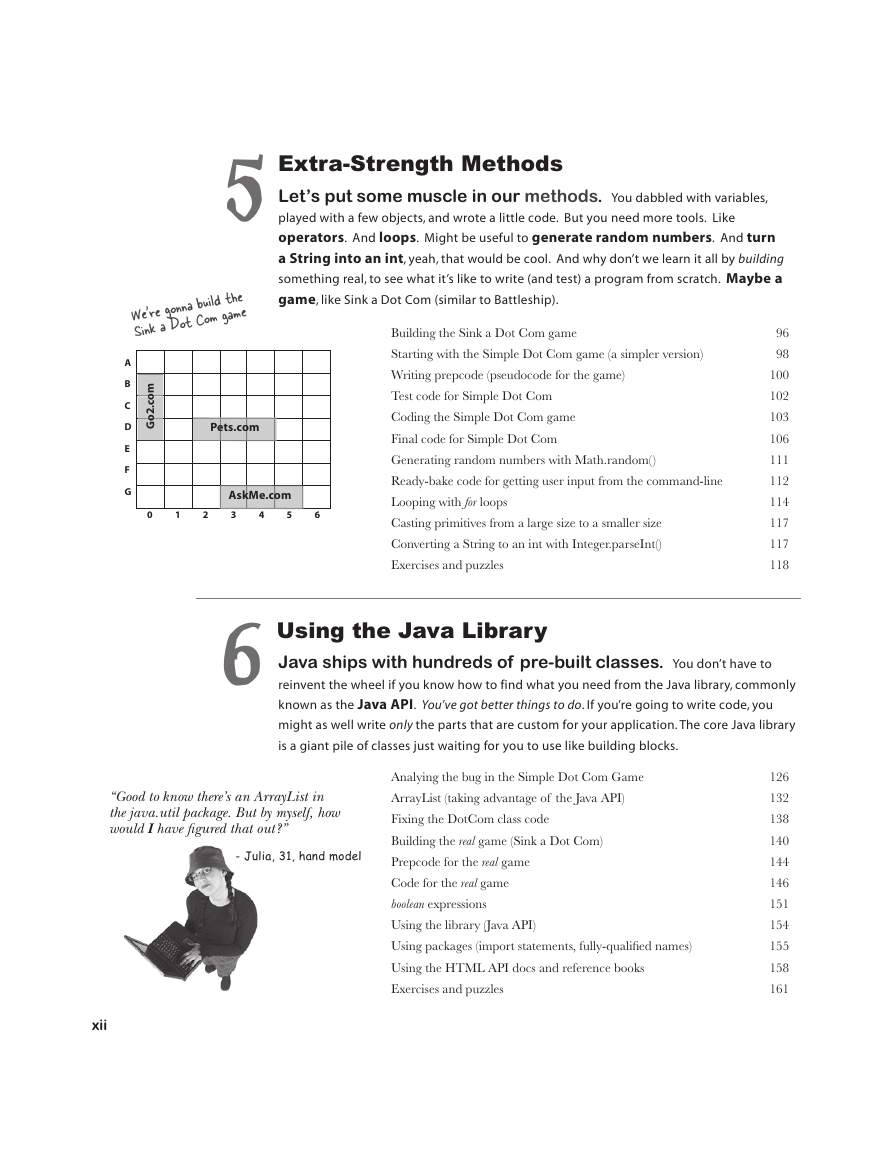
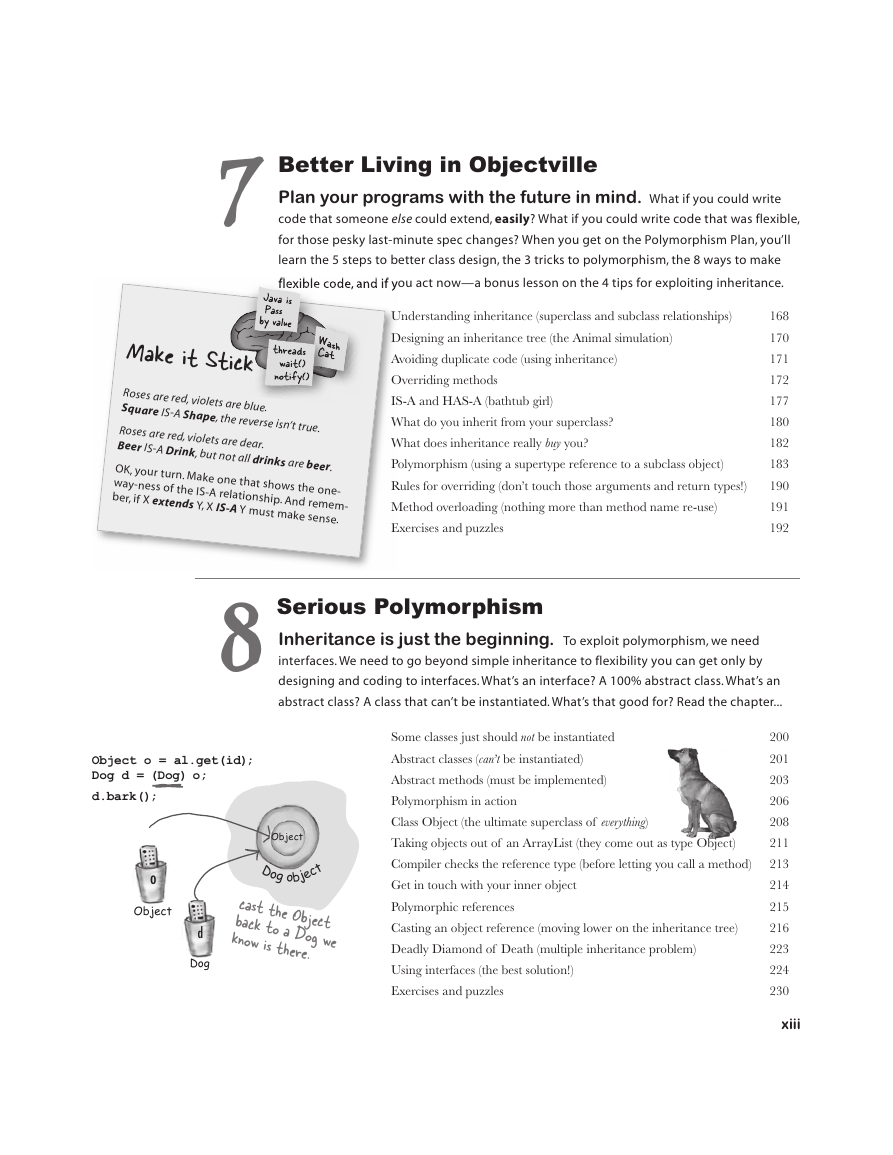
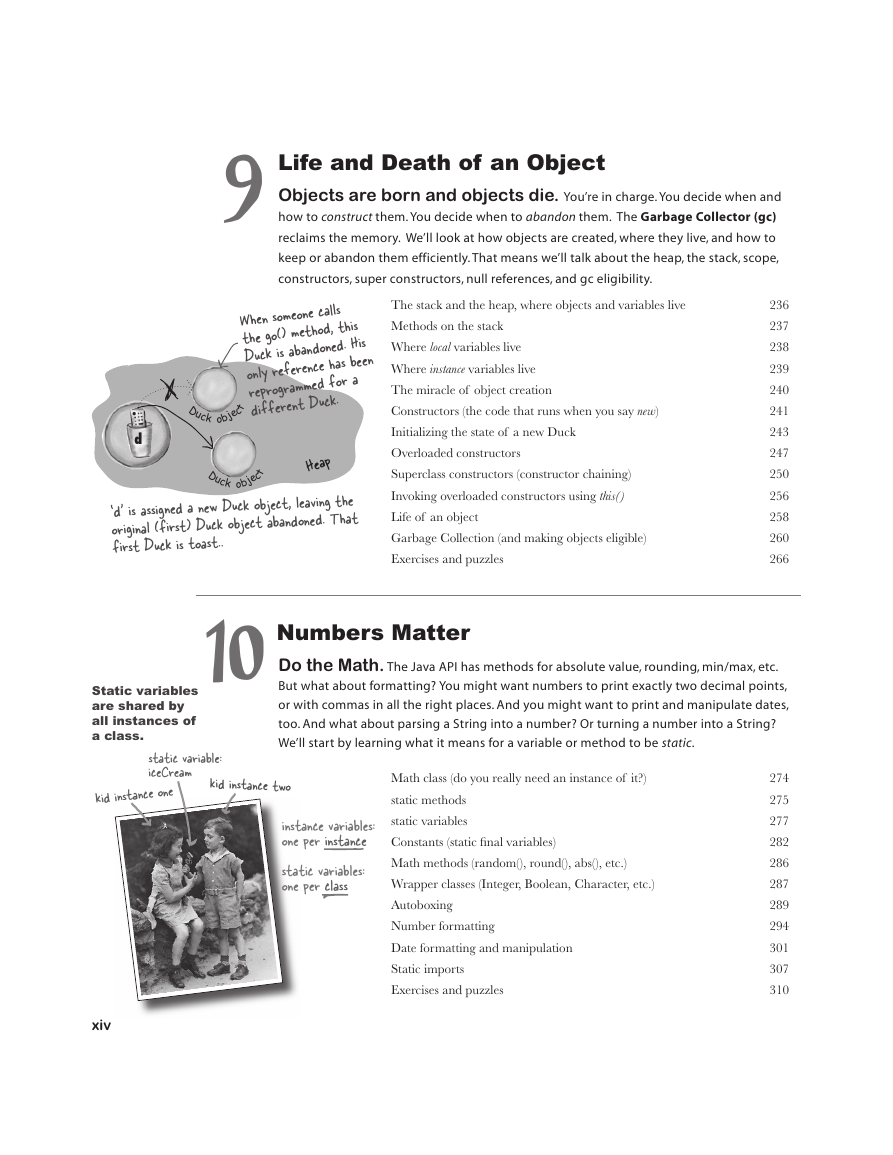
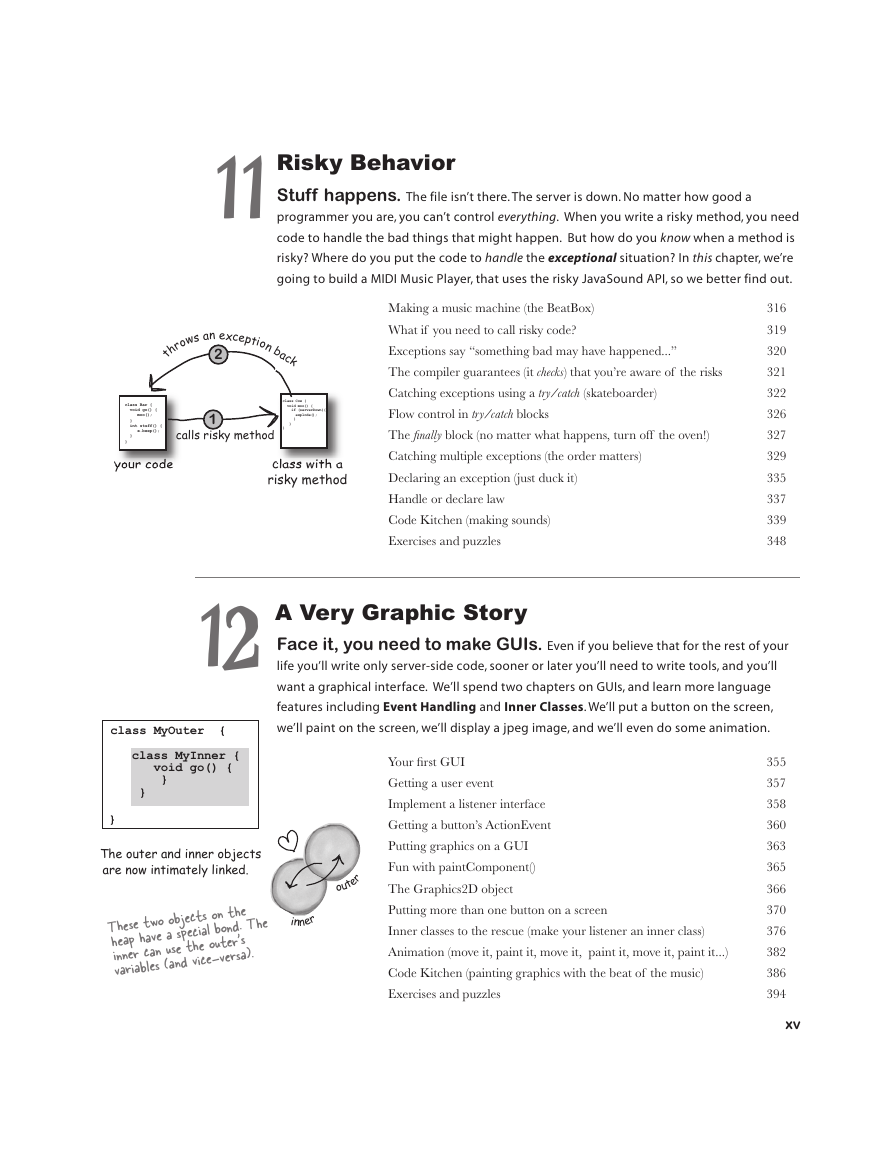








 2023年江西萍乡中考道德与法治真题及答案.doc
2023年江西萍乡中考道德与法治真题及答案.doc 2012年重庆南川中考生物真题及答案.doc
2012年重庆南川中考生物真题及答案.doc 2013年江西师范大学地理学综合及文艺理论基础考研真题.doc
2013年江西师范大学地理学综合及文艺理论基础考研真题.doc 2020年四川甘孜小升初语文真题及答案I卷.doc
2020年四川甘孜小升初语文真题及答案I卷.doc 2020年注册岩土工程师专业基础考试真题及答案.doc
2020年注册岩土工程师专业基础考试真题及答案.doc 2023-2024学年福建省厦门市九年级上学期数学月考试题及答案.doc
2023-2024学年福建省厦门市九年级上学期数学月考试题及答案.doc 2021-2022学年辽宁省沈阳市大东区九年级上学期语文期末试题及答案.doc
2021-2022学年辽宁省沈阳市大东区九年级上学期语文期末试题及答案.doc 2022-2023学年北京东城区初三第一学期物理期末试卷及答案.doc
2022-2023学年北京东城区初三第一学期物理期末试卷及答案.doc 2018上半年江西教师资格初中地理学科知识与教学能力真题及答案.doc
2018上半年江西教师资格初中地理学科知识与教学能力真题及答案.doc 2012年河北国家公务员申论考试真题及答案-省级.doc
2012年河北国家公务员申论考试真题及答案-省级.doc 2020-2021学年江苏省扬州市江都区邵樊片九年级上学期数学第一次质量检测试题及答案.doc
2020-2021学年江苏省扬州市江都区邵樊片九年级上学期数学第一次质量检测试题及答案.doc 2022下半年黑龙江教师资格证中学综合素质真题及答案.doc
2022下半年黑龙江教师资格证中学综合素质真题及答案.doc